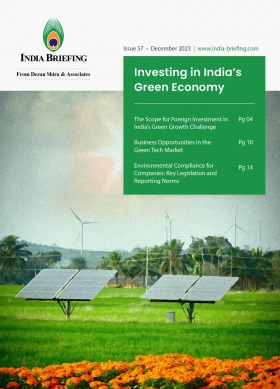PM Narendra Modi Virtually Inaugurates the 3 New Semiconductor Units on March 13
The Indian government approved the establishment of three new semiconductor manufacturing facilities on February 29 under the country’s flagship incentive program. Stakeholders have announced that construction work on these facilities will commence within the next 100 days.
Three new semiconductor units received approval from the Union Cabinet on February 29 under the initiative “Development of Semiconductors and Display Manufacturing Ecosystems in India”. They were virtually inaugurated by Prime Minister Narendra Modi on March 13, 2024.
Per some estimates, the three units could create direct employment of 20,000 advanced technology jobs and about 60,000 indirect jobs.
![]()
Source: Government of India
Webinar – India’s Top 5 Investment Destinations: Strengths and Opportunities for Foreign Businesses
Thursday, May 16, 2024 | 12:00 PM New York / 6:00 PM Brussels
Kyle Freeman, Partner at Dezan Shira & Associates, will introduce the top 5 most promising investment locations in India, providing an overview of their strategic strengths, factors driving their growth and highlight opportunities for foreign investment.
Join us in this free webinar.
The three new semiconductor manufacturing units are as follows:
- Semiconductor Fab with 50,000 wfsm capacity – at Dholera, Gujarat
This will be India’s first commercial semiconductor fabrication facility.
Tata Electronics Private Limited (TEPL) will collaborate with Powerchip Semiconductor Manufacturing Corp (PSMC), Taiwan, to establish a semiconductor fab in Dholera, Gujarat, with an investment of INR 9100 billion (US$109.71 billion). PSMC has six semiconductor foundries in Taiwan. The fab’s capacity will be 50,000 wafer starts per month (wfsm), covering segments such as high-performance compute chips with 28 nm technology and power management chips for electric vehicles (EV), telecom, defense, automotive, consumer electronics, display, power electronics, etc.
The chairman of PSMC, Frank Huang, said that the first semiconductor chip from this plant will be ready to roll out by the end of 2026. TEPL and PSMC are yet to finalize their joint venture terms but are prioritizing technology transfer at this time.
- Semiconductor ATMP (Assembly, Test, Marking and Packaging) unit – at Morigaon, Assam
Tata Semiconductor Assembly and Test Pvt Ltd (TSAT) will set up a semiconductor unit in Morigaon, Assam, with an investment of INR 2700 million (US$325.99 million). TSAT is developing indigenous advanced semiconductor packaging technologies, including flip chip and ISIP (integrated system in package) technologies. The unit’s capacity will be 48 million per day, catering to segments such as automotive, electric vehicles, consumer electronics, telecom, mobile phones, etc.
- Semiconductor ATMP unit for specialized chips – at Sanand, Gujarat
CG Power, in partnership with Renesas Electronics Corporation, Japan, and Stars Microelectronics, Thailand, will establish a semiconductor unit in Sanand, Gujarat, with an investment of INR 760 million (US$91.63 million). Renesas, a semiconductor company specializing in chips, operates 12 semiconductor facilities and is a key player in microcontrollers, analog, power, and System on Chip (SoC) products. The CG power semiconductor unit will manufacture chips for consumer, industrial, automotive, and power applications, with a capacity of 15 million per day.
India’s semiconductor program: Progress report
Modern technology is built on semiconductor chips, which are used to power everything from expensive drones and self-driving cars to cellphones. At present, the majority of the semiconductor manufacturing market is dominated by Taiwan, China, the United States, South Korea, and Japan.
With the launch of these three units, India can position itself as a global hub for chip manufacturing.
In the interim 2024 Union Budget, India increased the allocation for the scheme to support semiconductor and display manufacturing by 130 percent to INR 690.3 million (US$83.28 million). As per the finance documents produced by the central government, the revised estimate of expenditure for the ‘Modified Programme for Development of Semiconductors and Display Manufacturing Ecosystem in India’ in FY24 is INR 150.3 million (US$18.14 million).
Under is program, fiscal incentive of 50 percent of the project cost is available to companies/consortia/ joint ventures for setting up of semiconductor fabs in India of any node size (including mature nodes). Similarly, a fiscal incentive of 50 percent of the project cost is available for setting up of display fabs of specified technologies in India.
The application window for the semiconductor schemes are open till December 2024, including the Design Linked Incentive (DLI) Scheme. So far, India has received 26 applications under the DLI scheme, and five applications have been granted approval.
Given India’s strengths in chip design, the newly approved units will promote the development of chip fabrication capabilities, supporting homegrown packaging technology advancements. The change is expected to create new employment opportunities in addition to expanding semiconductor production capacity. As per the central government’s estimate, the three new units will directly affect 20,000 high-tech positions and indirectly create an additional 60,000 jobs.
India now has four semiconductor manufacturing facilities after the inclusion of the three new units. Prominent American chip company Micron has committed to invest up to US$825 million to build a facility in India for the assembly and testing of semiconductor chips. It plans to open a production facility at the Sanand plant in Gujarat in early 2025 for assembling and testing cutting-edge D-RAM and Nand products.
With Micron’s investment spread over two years, the project is estimated to generate 15,000 community employment and 5,000 direct jobs in coming years. Making use of the government’s “Modified Assembly, Testing, Marking, and Packaging (ATMP) scheme,” Micron will get fiscal help from the central government for 50 percent of the project cost, with an additional 20 percent coming from the Gujarat state government. Up to US$2.75 billion is anticipated to be invested jointly by Micron and the two governments for the two project phases.
Impact of the recent approvals
India anticipates a “ripple effect” that will speed up job prospects in downstream industries such as automotive, electronics, telecom, industrial, and other businesses that use semiconductors. By 2026, the semiconductor industry in India is anticipated to generate over 300,000 jobs, encompassing diverse roles such as testing, engineering, software development, system circuits, validation, and operations.
The country strategically aims to enhance its manufacturing capacity for export-oriented component production, resulting in a surge in research and development (R&D), testing activities, and technological capabilities. Given India’s expansive consumer and business marketplace, its proficiency in electronics production, and geopolitics affecting the nature of supply chains, the nation should capitalize on the opportunity to strengthen its position in global semiconductor value chains.
Over the next five years, India has the potential to establish additional facilities in the semiconductor assembly, testing, and packaging (ATP) segment, attracting fabs producing legacy semiconductors at 28 nm or above. This expansion aligns with India’s extensive experience in semiconductor design, boasting 20 percent of the world’s integrated circuit (IC) design workforce, comprising over 125,000 workers.
To attract multinational investors seeking stability and predictability, India must continue strengthening recent improvements in its business and policy environments, avoiding measures that could create uncertainty in the business landscape.
Outlook
According to a research report, the Indian semiconductor market reached a value of US$34.3 billion in 2023 and is projected to attain US$100.2 billion by 2032, exhibiting a compound annual growth rate (CAGR) of 20.1 percent during the forecast period spanning from 2023 to 2032.
With the growing popularity and production of electric vehicles (EVs) in India, it is projected that semiconductor use in fields including safety, electrification, communication, and networking would rise. These units, which prioritize developing job prospects and strengthening chip design strengths, have the potential to completely transform the semiconductor industry.
India’s enhanced allocation in the interim budget, together with its collaboration with US manufacturing giant Micron and the establishment of three new manufacturing facilities, highlight its commitment to becoming a leading manufacturer of semiconductor chips.
In order to realize its goal of becoming a significant player in the global semiconductor value chain, India needs to continue wooing high-tech investors and facilitate a pro-R&D environment – offering consistent and transparent financial and tax support as well as encouraging the cultivation of homegrown talents.
This article was originally published March 1, 2024. It was last updated March 13, 2024.
About us
India Briefing is produced by Dezan Shira & Associates. The firm assists foreign investors throughout Asia from offices across the world, including in Delhi and Mumbai. Readers may write to india@dezshira.com for more support on doing business in India.
We also maintain offices or have alliance partners assisting foreign investors in Indonesia, Singapore, Vietnam, Philippines, Malaysia, Thailand, Bangladesh, Italy, Germany, Australia, and the United States.
- Previous Article India, EFTA Sign TEPA Deal: Key Benefits Negotiated
- Next Article Examining India’s State Capex Performance in 2023-24








